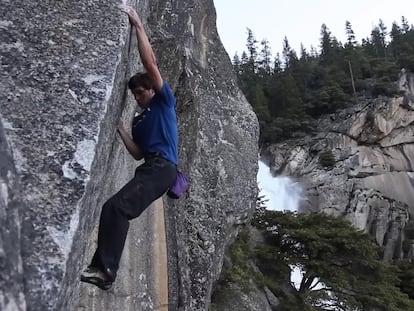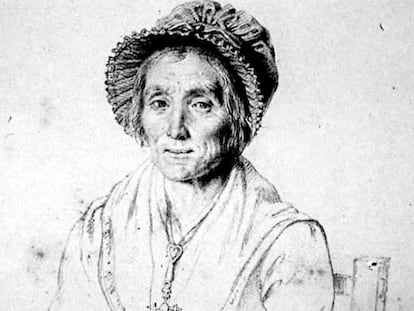Two climbers attempt first winter ascent of an eight-thousander in pure alpine style
David Göttler and Hervé Barmasse will take on the 8,167-meter Dhaulagiri summit with little more than a rope, crampons and axes: ‘Our chances of success are tiny, but they would be zero if we had stayed at home’
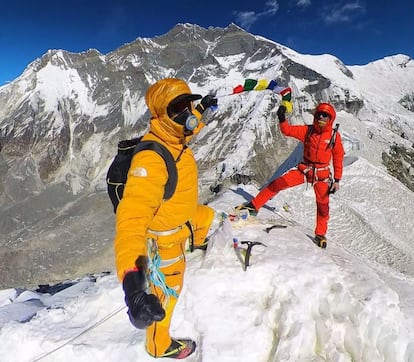
Dhaulagiri base camp is a desert of bare rock. Hurricane-strength winds have blasted away the snow and the dining tent slaps in cold applause as mountaineers David Göttler and Hervé Barmasse, and their cook, shift their eyes from one to another with a look of circumstance: the cold and wind chill are unbearable. “Honestly, our chances of success are tiny, but they would be zero if we had stayed at home,” admits Göttler. His climbing gear is a declaration of principles, the desire not to betray his own beliefs: the method comes above all, the ethics, the manner of approaching the problem of climbing a 8,167-meter mountain in winter according to an idea that, in his opinion, is non-negotiable: the alpine style.
“We want to respect ourselves and the mountain,” says Barmasse, an Italian raised in the shadow of the Matterhorn. Respect means staying true to an idea: confronting difficulties without minimizing the commitment, without shortcuts, without a safety net, without excuses... without what could be considered cheating. Göttler and Barmasse, both haute mountain guides, will take with them a 60-meter thin rope, two ice screws, a handful of carabiners, crampons and ice axes, eschewing fixed ropes, fixed high-altitude camps, oxygen and the invaluable help of Sherpas. “We want to do something that hasn’t been done before, to mark a turning point in the history of winter ascents of eight-thousanders, and right now alpine style is the only way to be consistent with this desire to differentiate ourselves from what has been done so far,” Göttler says.
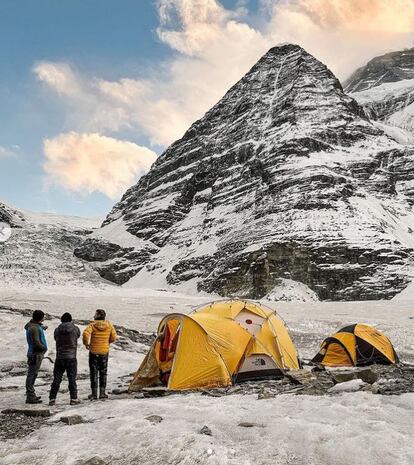
His gaze on history, Göttler comes across the footprint of the colossal Polish mountaineer Jerzy Kukuczka, who in his contest with Reinhold Messner to be the first to climb all 14 eight-thousanders, made four winter ascents on Dhaulagiri, Cho Oyu, Kangchenjunga and Annapurna I. “We don’t want to do better than Kukuczka. I have immense respect for what climbers of past generations did. In my case, it’s about doing something that really motivates me and drives me to find my limits in mountaineering. That’s why we have chosen the alpine style: two people alone, who will leave no trace in their wake because we carry everything up and come back with everything in our backpacks. I climbed Dhaulagiri in the spring in 2008 and it was one of the easiest expeditions of my career, but now it’s a different game. I know it’s doable, but I also know we’re only going to have one chance, which drastically limits our chances of success, a condition that motivates us,” says Göttler.
The most curious thing about winter ascents is that analysts rarely agree when it comes to deciding when it is winter: some cite the meteorological winter and consider the dates from December 1 to February 28 as valid. Others choose the astronomical winter, between December 21 and March 21. Thus, the brilliant alpine-style ascent of Dhaulagiri by Erhard Loretan, Jean Troillet and Pierre-Alain Steiner on December 6, 1985, remains in limbo, as for part of the Himalayan climbing community it was not strictly achieved in winter.
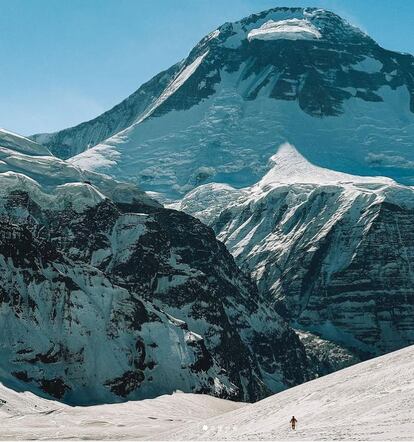
Mountaineering grows when climbers decide to take on the challenge of improving on what others have done. The sport takes its references from the past, a lever from which it is possible to dream of new paths, challenges and adventures. Making history remains within the reach of a chosen few. Modern mountaineers benefit from better training, more efficient and lighter equipment and the knowledge passed down by others who dared to go a step further in the search for new challenges. The rewards are commensurate with what one stands to lose by betting big.
A recent winter expedition led by Alex Txikon on Manaslu used fixed ropes, bottled oxygen and a team of six Sherpas. “Personally, I wouldn’t have wanted to climb Manaslu in winter like that, but that doesn’t mean it’s a bad climb or the wrong style. Last spring, I climbed Everest without artificial oxygen, but I used the fixed ropes, for example. I don’t want to judge how others do things. The beauty of mountaineering is that there are no rules and everyone can climb as they wish. The only responsibility that this freedom entails is the obligation to communicate what has been done truthfully and honestly, to explain how the mountain has been climbed. Only in this way can we preserve our credibility with respect to the mountaineering community and public opinion,” says Goettler.
In the winter of 1984-85, Kukuczka pulled off a masterful double: on January 21, he reached the summit of Dhaulagiri and on February 15, he set foot on the summit of Cho Oyu, both without using artificial oxygen. But his approach to both ascents was seen by the Polish expeditions as that of a star soccer forward waiting at the top, without getting involved in defense or playmaking, to score and win the game. On Dhaulagiri, Kukuczka arrived when his compatriots had been working for a month, installing fixed ropes and altitude camps, as well as dodging monstrous avalanches that swept through their base camp. “It was the worst winter in 27 years, with only a handful of days without snow, storms or fierce winds that shook us for seven weeks,” Adam Bilczewski would recall in 1985.
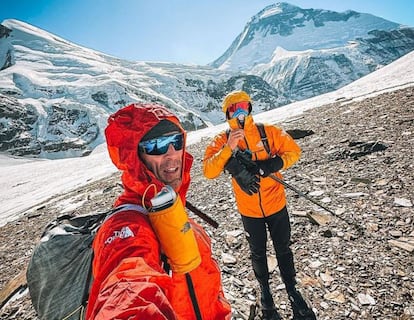
Kukuzcka’s courage and drive gave him one more gear to reach the summit and endure an epic return trip. He and his partner Andrzej Czok got lost in a gale, unable to reach the last altitude camp, being forced to bivouac and costing Czok severe frostbite. While some of the expedition headed for the hospital, Kukuczka started a race against the clock to join another Polish expedition that was attempting the first winter summit of Cho Oyu. He arrived just in time to summit, although he did so after the great Maciej Berbeka and his friend Maciej Pawlikowski took first place honors.
Barmasse and Göttler attempted the Rupal slope on Nanga Parbat in alpine style last winter. Terrible winds barely allowed them to progress on the wall, but they intended to return this season before switching their focus at the last minute to Dhaulagiri, one of the most visited eight-thousanders in winter. Now, once again, the same winds threaten to ruin their enterprise, but they have announced that they will stay at least 20 more days waiting for an improvement, a crack that will allow them to launch themselves swiftly, light and isolated toward an unknown in which the only certainty is that they will be tied together by a rope a few millimeters thick.
Sign up for our weekly newsletter to get more English-language news coverage from EL PAÍS USA Edition
Tu suscripción se está usando en otro dispositivo
¿Quieres añadir otro usuario a tu suscripción?
Si continúas leyendo en este dispositivo, no se podrá leer en el otro.
FlechaTu suscripción se está usando en otro dispositivo y solo puedes acceder a EL PAÍS desde un dispositivo a la vez.
Si quieres compartir tu cuenta, cambia tu suscripción a la modalidad Premium, así podrás añadir otro usuario. Cada uno accederá con su propia cuenta de email, lo que os permitirá personalizar vuestra experiencia en EL PAÍS.
¿Tienes una suscripción de empresa? Accede aquí para contratar más cuentas.
En el caso de no saber quién está usando tu cuenta, te recomendamos cambiar tu contraseña aquí.
Si decides continuar compartiendo tu cuenta, este mensaje se mostrará en tu dispositivo y en el de la otra persona que está usando tu cuenta de forma indefinida, afectando a tu experiencia de lectura. Puedes consultar aquí los términos y condiciones de la suscripción digital.
More information
Últimas noticias
Maduro pleads not guilty before the federal court in New York: ‘I am still the president of Venezuela’
A new test can detect Alzheimer’s from a finger prick
UN team enters Sudanese city of El Fasher after paramilitary massacre: ‘It’s like a ghost town’
A recipe for resistance: Indigenous peoples politicize their struggles from the kitchen
Most viewed
- Gilles Lipovetsky: ‘If you want to live better and fall in love, take Prozac, don’t look to philosophy’
- Alain Aspect, Nobel laureate in physics: ‘Einstein was so smart that he would have had to recognize quantum entanglement’
- Alvin Hellerstein, a 92-year-old judge appointed by Bill Clinton, to preside over Maduro’s trial in New York
- Why oil has been at the center of Venezuela-US conflicts for decades
- Maduro’s downfall puts China’s relationship with Venezuela to the test

